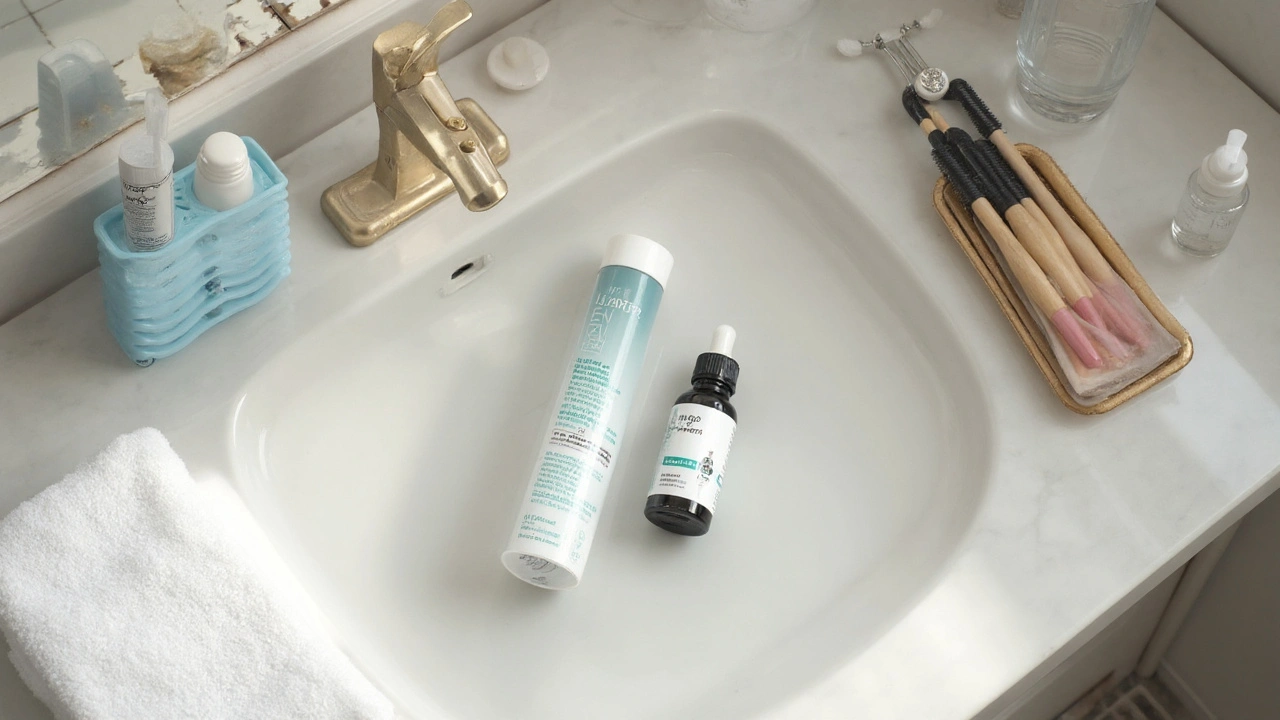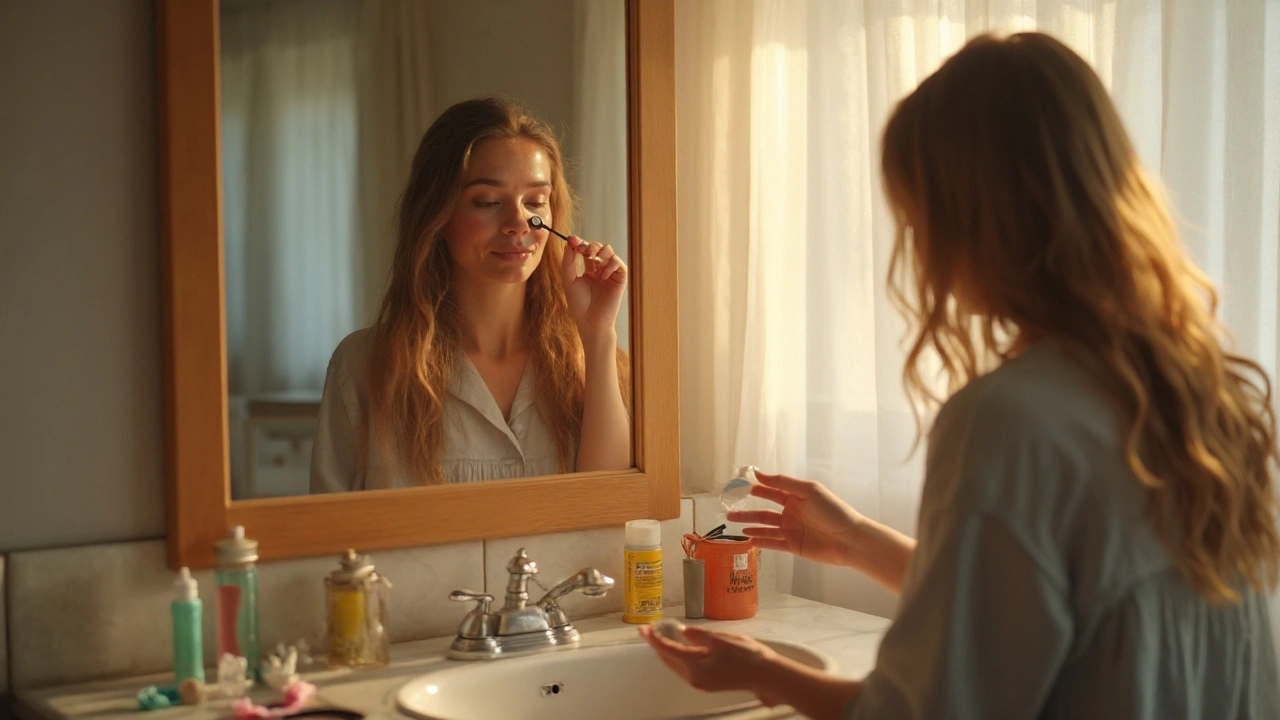You shouldn’t have to quit your favorite eyeliner just because you’re treating glaucoma. The challenge is making eye makeup play nice with your drops-no smudging your dose, no red, irritated lids, and no sneaky infections from old mascara. This guide gives you a simple daily routine, safe product choices, and clear rules for timing, so your treatment stays effective and your eyes stay comfortable.
Quick reality check: prostaglandin drops can redden eyes, lengthen lashes, and sometimes darken the skin around the lids. Makeup can either help you look fresher-or make all that worse. You’ll get practical, evidence-backed steps here, not vague advice. I live in Toronto, where winter air is extra dry, so I’m mindful of comfort. You’ll see that approach in the tips below.
TL;DR and What Actually Works
latanoprost lowers your intraocular pressure best when used once nightly and left alone to absorb. If you handle makeup right, you can still wear it daily.
- Time it right: Use latanoprost at night. In the morning, apply makeup without worrying about washing out your dose. If you must use drops during the day, put them in first, then wait 10-15 minutes before makeup.
- Keep the 5-15 rule: Leave 5 minutes between different eye drops; wait 15 minutes before putting in contact lenses or putting anything on the eye area (makeup, creams) after a drop.
- Pick calm formulas: Hypoallergenic, fragrance-free, non-waterproof mascara and eyeliner. Skip glitter and tightlining (lining the waterline). Choose “tubing” mascaras-they wash off with warm water, no harsh rubbing.
- Remove gently: Take makeup off before your nightly dose. Use a gentle remover, wipe downward and outward, and keep remover off the lid margin. Pat dry. Then apply your drop.
- Hygiene matters: Replace mascara and liquid liners every 3 months. Clean brushes weekly. Don’t share eye makeup. If you get redness, burning, or discharge, stop makeup and call your eye doctor.
Why believe these rules? They line up with guidance from the American Academy of Ophthalmology (on makeup hygiene and application safety), FDA labeling for latanoprost (dosing and contact lens timing), and glaucoma organizations that highlight common side effects and comfort tips. If irritation persists, ask your doctor or pharmacist about preservative-free options or BAK-free formulations-especially helpful for dry, sensitive eyes.

Step-by-Step: A Safe Routine for Drops, Makeup, and Removal
Here’s a practical way to handle mornings, nights, and everything in between. Adjust it to your life, but stick to the timing, hygiene, and gentleness.
Night routine (best for most people):
- Remove eye makeup first. Use a gentle, oil-based remover or micellar water. Soak a cotton pad; press it on the lid for 10 seconds; wipe downward and outward. Avoid rubbing along the lash line. Keep remover out of the eye itself.
- Clean the eyelids. Rinse with lukewarm water. If you get crusting or flaking, a lid wipe or diluted baby shampoo (a tiny drop in a cup of water) can help. Rinse and pat dry.
- Apply your drop. Tilt your head back. With clean hands, pull down the lower lid to make a little pocket. Instill one drop without touching the bottle to lashes or skin. Close eyes gently (don’t squeeze) for 1-2 minutes. Press a finger on the inner corner (punctal occlusion) to limit drainage into your nose. This helps the drop stay where it should and reduces side effects.
- Keep skincare away from the lash line. If you use heavy night creams or oils, leave a small gap at the lid margin. That avoids residue that can seep into the eye.
Morning routine (if your drop is at night):
- Start with clean, dry lids. If you use contacts, put them in after your facial skincare is fully absorbed.
- Makeup choices that go easy on your eyes: use a pencil or gel eyeliner above the lash line (not on the waterline). Choose neutral, non-shimmer shadows. Go for non-waterproof or tubing mascara. Avoid fiber mascaras that shed.
- Apply makeup with a light hand. Use short strokes and avoid dragging product along the lid margin where your meibomian glands live. Those oil glands keep tears stable-blocking them leads to gritty eyes.
- Allergy test new products. Try new liners or removers on one eye for a day to see how your eyes react.
Daytime dosing (only if your prescriber told you to):
- Use the drop first and wait at least 10-15 minutes before makeup. That cushion avoids washing away the medicine.
- If you use more than one eye drop, separate them by 5 minutes. This reduces dilution.
- Contacts out. If you wear contacts, remove them before the drop and wait 15 minutes before putting them back in. This matches regulator labeling and reduces preservative exposure to lenses.
Makeup removal without drama:
- Go gentle. The goal is to avoid friction that triggers redness and broken capillaries. Let the remover do the work.
- Follow a direction. Wipe downward toward the cheek, then outward. Don’t scrub side-to-side over the lash line.
- No cotton fuzz in your eye. If you’re sensitive, switch to lint-free pads or reusable microfiber cloths designed for eyes.
- Do it before your night dose. Clean lids, then drops. This avoids remover residue interfering with your medicine.
Side-effect aware makeup choices:
- Redness and dryness: pick creamy, non-irritating formulas; avoid alcohol-heavy liquid liners. A sheer peach corrector under the eye can help with color without needing piles of product on the lids.
- Lash growth from prostaglandins: pleasant surprise, but it can cause clumping. Use a clean spoolie to comb through before mascara. Skip lash extensions; adhesives can inflame lids and make cleaning harder.
- Eyelid skin darkening or hollowing: a thin veil of concealer at the upper lid crease softens the shadowing. Don’t try to “cover” it with heavy oils near the lash line-they migrate and irritate.
What to avoid, most of the time:
- Tightlining (waterline liner). It blocks meibomian glands and can smear pigment onto the ocular surface. If you must do it, keep it rare and minimal.
- Glitter and loose shimmer. Those particles migrate and scratch.
- Waterproof mascara every day. Great staying power, harsh removal. Save it for special events.
- Old products. The AAO and many ophthalmology groups recommend replacing mascara and liquid liners at 3 months. It reduces bacterial buildup.
| Product | Better choices | Avoid or limit | Notes |
|---|---|---|---|
| Mascara | Tubing; fragrance-free; ophthalmologist-tested | Waterproof daily; fiber-heavy; scented | Tubing formulas come off with warm water-less rubbing on lids |
| Eyeliner | Soft pencil or gel above lash line | Tightlining on waterline; glitter liners | Keep a 1-2 mm gap from lash roots to protect oil glands |
| Eyeshadow | Pressed, satin-matte; hypoallergenic | Loose glitter; chunky shimmer | Tap off excess to prevent fallout into eyes |
| Concealer | Fragrance-free cream/liquid | Heavy oils on the lid margin | Apply below the lash line, not into it |
| False lashes | Generally skip | Cyanoacrylate/glues; extensions | Adhesives can inflame lids; harder to clean long lashes from drops |
| Makeup remover | Oil-based balm or micellar water | Strong alcohol-based removers | Soak, press, then wipe-no scrubbing |
| Tools | Clean brushes weekly; replace sponges | Shared applicators | Wash with gentle soap; air dry fully |
Why these picks? They’re kinder to the ocular surface. Prostaglandin drops can cause conjunctival hyperemia (that red look) and dryness. Gentler, low-friction products reduce the chance you’ll bail on treatment because your eyes feel cranky.
About preservatives and comfort:
- Many standard bottles contain benzalkonium chloride (BAK). BAK is effective at keeping drops sterile, but it can irritate dry or sensitive eyes-especially with contacts.
- Preservative-free single-dose vials or newer PF bottles exist in some markets. Ask your ophthalmologist or pharmacist what’s available where you live in Canada and whether it suits your case.
- Even with BAK, careful timing and lid hygiene often fix most makeup-related irritation.
Evidence and guidance notes you can trust:
- FDA and Health Canada labeling: once-daily dosing in the evening is recommended for prostaglandin analogs; remove contacts before dosing; wait 15 minutes to reinsert.
- American Academy of Ophthalmology: discard mascara and liquid liners every 3 months; avoid tightlining if you have dry eye or gland issues; clean brushes regularly.
- Glaucoma Research Foundation and Canadian Ophthalmological Society: prostaglandin side effects can include redness, eyelash changes, and periorbital skin darkening; punctal occlusion can reduce systemic absorption and some side effects.

Checklists, Picks, and Your Follow‑up Questions
Quick checklists you can screenshot:
Makeup + drops timing (5-15 rule):
- 5 minutes between different eye drops
- 10-15 minutes from drop to makeup
- 15 minutes from drop to contact lens back in
- Nighttime: remove makeup → clean lids → drop → light skincare (not on the lash line)
Hygiene habits that prevent irritation:
- Mascara and liquid liner: replace every 3 months
- Pencils: sharpen regularly; replace by 6-12 months if used near waterline (or avoid waterline use)
- Brushes: wash weekly with gentle soap; dry fully
- Storage: keep makeup dry and closed; not in a steamy bathroom
- Never share eye makeup or tools
Comfort boosters (especially in dry, cold climates like Toronto winters):
- Humidifier at home
- Warm compress 5-10 minutes in the evening to keep meibomian oils flowing
- Preservative-free lubricating drops during the day (space them 5 minutes apart from medicated drops)
- Sunglasses outdoors to cut wind, glare, and tearing
Decision mini‑tree when eyes misbehave:
- If your eyes feel gritty or burn after makeup: switch to tubing mascara and gel liner; avoid shimmer. Add a warm compress. If it persists, take a makeup break for 2-3 days.
- If redness spikes after your drop: confirm you’re not rubbing or overusing more than once nightly. Try punctal occlusion. If still red, ask about PF options.
- If lashes get very long and tangled: use a clean spoolie; try one light coat of mascara or skip it. Avoid lash extensions and heated curlers.
- If lids darken: lighten makeup load near the lash line; use a thin layer of peach-toned concealer on the upper lid crease. Discuss with your ophthalmologist if it bothers you cosmetically.
Common questions, answered fast:
- Can I wear waterproof mascara? Yes, but not daily. It needs more rubbing to remove. Save it for long days or events. Use a gentle oil remover and avoid scrubbing the lash line.
- Is tightlining ever okay? Better to avoid. It blocks oil glands and drives pigment onto the eye’s surface. If you insist, use it sparingly and clean lids carefully at night.
- Can I use my drop over makeup? Try not to. You’ll wash pigment into your eye and contaminate the bottle. If you must dose during the day, instill the drop on clean lids and wait 10-15 minutes before reapplying any makeup.
- Do lash serums clash with glaucoma drops? Many cosmetic serums use prostaglandin analogs or irritants. You already have a prostaglandin working. Skip extra serums unless your eye doctor approves.
- Are lash extensions okay? Not ideal. Adhesives and removal stress the lid margin, and long lashes are harder to keep clean around medication time.
- Will makeup color change my eye color when I’m on prostaglandins? Eye color changes (iris darkening) are a known medication effect for some people with lighter irises, not a makeup effect.
- How about eyeliner tattoos (permanent makeup)? This puts pigment near the lid margin-risky for gland function and future irritation. Discuss with your ophthalmologist first.
When to pause makeup and call your doctor:
- New or worsening pain, light sensitivity, or vision changes
- Thick discharge or crusting that doesn’t clear with hygiene
- Severe, persistent redness or swelling after you apply makeup or drops
- Rash around the eyes
Product label pro tips (from prescribing info and ophthalmology guidance):
- Use your drop once nightly. More is not better and can reduce effectiveness.
- Don’t touch the bottle tip to anything-lashes, lid, skin. That’s how bottles get contaminated.
- If you miss a dose, take it the next night. Don’t double up.
- Contact lenses out before dosing; wait 15 minutes to reinsert.
If you have specific situations:
- Contact lens wearers: favor daily disposables. They stay cleaner and reduce preservative build‑up. Follow the 15‑minute rule religiously.
- Very sensitive eyes: ask about preservative‑free latanoprost. Switch to minimalist makeup: tubing mascara, gel liner above the lash line, matte shadow. Keep remover simple-pure micellar water or a mild balm.
- Post‑eye surgery (like cataract): your surgeon may ask you to avoid makeup for a period. Follow that timeline strictly.
- Makeup artists or performers: keep a personal kit for your eyes; no sharing. Use disposable wands. Replace liquids frequently.
If you’re wondering about evidence on makeup hygiene: ophthalmology groups emphasize the 3‑month swap for mascara/liquid liners to reduce bacterial contamination. Studies of used mascaras show bacteria can grow after weeks of use, especially when products are old or shared. That’s why the 3‑month rule is worth following even if the tube looks fine.
Putting it all together, here’s a simple day-night sample routine many patients in clinic end up using:
- Morning: facial skincare → contacts (if any) → light eye makeup (pencil/gel above lash line, tubing mascara) → sunglasses outdoors.
- Day: if eyes feel dry, a preservative‑free artificial tear (not right up against a medication dose). Avoid re-lining the waterline midday.
- Evening: soak a cotton pad with remover → press, then wipe down/out → rinse → pat dry → instill your glaucoma drop → gentle warm compress for 5 minutes → light moisturizer (not into the lash line).
If you stick to this, most of the common problems-smudged doses, red lids, irritated glands-drop off fast. You get the control you want over your glaucoma treatment and the confidence you want from your makeup bag.







Comments
Eileen Peck
26 August 2025I totally get the struggle of keeping lashes on point while using latanoprost. Its easy to forget the 10‑15 minute wait and end up smudging the dose. I usually set a timer on my phone right after I apply the drop, then do my makeup once the alarm goes off. Keeping mascara and liner hypoallergenic has saved me from a lot of redness, and swapping them out every three months feels like a small price to pay for comfort.
Oliver Johnson
31 August 2025Honestly makeup is just a distraction from the real battle – just focus on the drops.
Taylor Haven
5 September 2025When you look at the way big pharma pushes prostaglandin analogs, you have to wonder if they really care about your comfort or just their bottom line. The fact that they label the drops with vague warnings about “possible redness” is a classic example of strategic ambiguity. Every time you dab on eyeliner, you are inviting a tiny gateway for preservatives to sneak into the ocular surface. The preservative benzalkonium chloride, while effective at killing microbes, is a known irritant that can exacerbate dry eye, especially in winter climates like Toronto. If you pair that with a fragrance‑laden mascara, you are essentially signing a waiver for inflammation. The guidelines from the AAO are there, but they are often buried under layers of regulatory jargon that most patients never see. That’s why a simple routine-remove makeup, clean lids, wait, then apply-becomes a subversive act of self‑care. Think of your eye drop as a tiny soldier that needs a clear battlefield; any stray glitter or oil is like a minefield. Replacing mascara every three months isn’t just good hygiene, it’s a defense against bacterial colonisation that can turn a mild irritation into a full‑blown infection. The 5‑minute rule between different eye drops isn’t arbitrary, it’s based on studies showing that premature mixing dilutes efficacy. You should also be aware that many over‑the‑counter eye cosmetics contain hidden surfactants that strip the tear film, undermining the very purpose of your latanoprost. Some patients even report that the medication darkens the periorbital skin, a side effect that’s often shrugged off as “normal”. Yet that pigment change can be a psychological burden, especially when society places a premium on flawless appearance. By choosing tubing mascara, you eliminate the need for harsh rubbing, which preserves the meibomian glands that are essential for tear stability. A gentle warm compress before bedtime can boost those glands, making the drop work more efficiently. In short, the battle isn’t just against intra‑ocular pressure; it’s against a cascade of commercial and physiological hurdles that you can outsmart with mindful habits.
Sireesh Kumar
9 September 2025That’s a solid rundown, but the “tiny soldier” metaphor might be a bit much for most folks. Practically, just sticking to the 10‑15 minute window and using non‑waterproof mascara does the trick for me. Also, the warm compress tip is gold – it really helps my lids feel less tight.
Jonathan Harmeling
14 September 2025You’re right, the practical steps matter more than poetic analogies. However, I’d add that checking the expiration date on any eye product is a moral responsibility; using old mascara can be a silent health hazard. And let’s not forget to clean brush handles weekly – a detail often ignored.
Ritik Chaurasia
18 September 2025In many cultures, eye adornment is tied to identity, so dismissing it outright feels like cultural erasure. Instead, we should advocate for safe options that respect tradition while protecting health.
Gary Marks
23 September 2025Honestly, I skimmed through the whole guide and felt a bit underwhelmed by the lack of personal anecdotes. I’ve tried a few “preservative‑free” drops and they didn’t make a dent in my dryness; the real problem was my habit of rubbing my eyes after makeup. The guide mentions a warm compress, but doesn’t explain that you need a consistent routine – like doing it every night for at least a week before you see any difference. Also, the recommendation to replace mascara every three months is fine, but many people forget they also need to replace the applicator tip if it’s a brush, not just the tube. Lastly, there’s no mention of using a humidifier in dry climates, which can be a game‑changer for anyone in a place like Toronto during winter.
Vandermolen Willis
28 September 2025Thanks for the thorough rundown! 😊 The emoji‑friendly reminder to set a timer really helped me stay on track.
Mary Keenan
2 October 2025Skip the glitter – it’s a pain.
Steven Young
7 October 2025Gary you missed the point the guide is about timing not just product swaps it’s simple wait ten minutes after drops then do makeup no need to overthink it
Kelly Brammer
12 October 2025Keeping the routine short and consistent is key; the 15‑minute rule really does the trick.
Ben Collins
16 October 2025Oh sure, because everyone has exactly fifteen minutes to spare between a drop and a perfect cat‑eye – sarcasm aside, a little flexibility never hurt anyone.
Denver Bright
21 October 2025I think it’s a bit invasive to tell people exactly how long they should wait; personal schedules vary and not everyone can stick to a rigid timeline.
Kelli Benedik
26 October 2025💔 I hear you, but think of the irritation you avoid when you give those extra minutes a chance – it’s a tiny sacrifice for a lot of comfort later. 😅
cariletta jones
30 October 2025Stick to the basics and you’ll keep both eyes and style on point.
Kevin Hylant
4 November 2025Follow the steps and the drops work better.